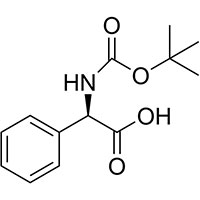Synonyms
Boc-L-α-phenylglycine
Boc-L-a-phenylglycine
N-(tert-Butoxycarbonyl)-D-2-phenylglycine
N-{[(2-Methyl-2-propanyl)oxy]carbonyl}-N-phenylglycine
N-Boc-L-2-phenylglycine
N-Boc-(S)-2-phenylglycine
BOC-L-alpha-phenylglycine
Boc-D-Phg-OH
N-tert-butoxycarbonyl-L-phenylglycine
[(tert-Butoxycarbonyl)amino](phenyl)acetic acid
(S)-N-Boc-phenylglycine
N-(tert-Butoxycarbonyl)-N-phenylglycine
MFCD00065588
BOC-DL-(PHENYL)GLY-OH
BOC-D-alpha-phenylglycine
(S)-N-(tert-butoxycarbonyl)-2-phenylglycine
Boc-L-phenylglycine
Product Description
Introduction:
BOC-D-Phenylglycine is a crucial amino acid protecting agent widely used in peptide synthesis. With its
exceptional compatibility, stability, and versatility, BOC-D-Phenylglycine enables the synthesis of
peptides containing phenylglycine residues. Its high purity and reliable performance make it an
indispensable tool for chemists and researchers involved in peptide synthesis projects.
Product Features:
High Purity: BOC-D-Phenylglycine is produced with meticulous care to ensure the highest level of purity,
minimizing impurities. Its superior quality guarantees the synthesis of peptides with excellent purity
and structural integrity.
Effective Protecting Group: BOC-D-Phenylglycine serves as a reliable protecting group for the amino
group of phenylglycine, preventing unwanted reactions during peptide chain elongation. By selectively
shielding the amino group, it enables controlled incorporation of phenylglycine into peptides.
Versatile Applications: BOC-D-Phenylglycine finds extensive use in the synthesis of peptides with
phenylglycine residues. Peptides containing phenylglycine exhibit unique conformational properties,
increased stability, and altered binding affinity, making them valuable in drug discovery, peptide-based
therapeutics, and biochemical research.
Applications:
Peptide-Based Therapeutics: BOC-D-Phenylglycine plays a crucial role in the synthesis of peptide-based
therapeutics. Incorporation of phenylglycine residues can enhance the peptide's stability, improve
protease resistance, and fine-tune the peptide's interactions with its target, increasing therapeutic
efficacy. Peptide drugs containing phenylglycine have shown potential in areas such as oncology,
diabetes, and neurodegenerative diseases.
Molecular Probes and Imaging Agents: BOC-D-Phenylglycine facilitates the synthesis of peptides used as
molecular probes and imaging agents. These peptides can be labeled with various fluorophores or imaging
moieties, enabling targeted imaging of specific cells or tissues. Phenylglycine-containing peptides have
been employed in molecular imaging techniques, such as fluorescence imaging and positron emission
tomography (PET).
Biochemical Research: BOC-D-Phenylglycine is an essential tool in biochemical research, enabling the
synthesis of peptides with phenylglycine residues for studying protein-protein interactions, enzymatic
mechanisms, and signal transduction pathways. By incorporating phenylglycine, researchers can gain
valuable insights into the structure-function relationships of proteins and develop novel tools for
investigating biological processes.
Market Outlook:
The demand for BOC-D-Phenylglycine is steadily growing due to its significant role in peptide synthesis
and biochemical research. Pharmaceutical companies, academic institutions, and research laboratories
extensively utilize BOC-D-Phenylglycine in the development of peptide-based therapeutics, molecular
probes, and imaging agents. As the field of peptide therapeutics and molecular imaging continues to
advance, the market for amino acid protecting agents like BOC-D-Phenylglycine is expected to witness
continued growth.
Conclusion:
BOC-D-Phenylglycine is a versatile and reliable amino acid protecting agent used in peptide synthesis.
Its high purity, effective protection of the amino group, and compatibility with various synthesis
techniques enable the incorporation of phenylglycine residues into peptides, leading to enhanced
structural diversity and unique functional properties.





